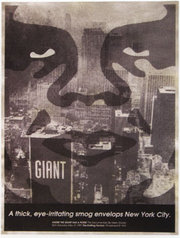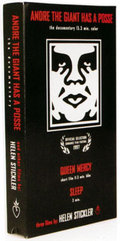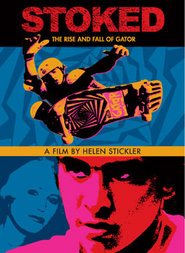Helen Stickler (Difference between revisions)
From The Giant: The Definitive Obey Giant Site
m (→About working with Shepard) |
Illyanadmc (Talk | contribs) m |
||
| Line 12: | Line 12: | ||
==About working with Shepard== | ==About working with Shepard== | ||
| − | From [[Supply and Demand Book|Supply and Demand]]<br> | + | From ''[[Supply and Demand Book|Supply and Demand]]'':<br> |
I first noticed [[Shepard Fairey|Shep's]] original black-and-white [[sticker]] on a light box at [[RISD]] in Providence, Rhode Island, in 1989. I remember cynically thinking that the use of be word "posse" was another attempt by the suburban bourgeois to mimic hip-hop culture, because there weren't too many kids from the 'hood at that school. But because the sticker was absurdly idolizing a professional wrester, the clash of cultures and adoption of trends was one of the points it made. | I first noticed [[Shepard Fairey|Shep's]] original black-and-white [[sticker]] on a light box at [[RISD]] in Providence, Rhode Island, in 1989. I remember cynically thinking that the use of be word "posse" was another attempt by the suburban bourgeois to mimic hip-hop culture, because there weren't too many kids from the 'hood at that school. But because the sticker was absurdly idolizing a professional wrester, the clash of cultures and adoption of trends was one of the points it made. | ||
| Line 18: | Line 18: | ||
Later, I saw Shep's giant Andre face over the mayor's election campaign billboard, and was impressed - the scale was significant, and alignment with a political gesture we subtle social commentary. | Later, I saw Shep's giant Andre face over the mayor's election campaign billboard, and was impressed - the scale was significant, and alignment with a political gesture we subtle social commentary. | ||
| − | In 1994, I finished debuting my short Queen Mercy and wanted to follow it up. At the same time, Shep was plastering Providence with a parody of Coca- | + | In 1994, I finished debuting my short ''Queen Mercy'' and wanted to follow it up. At the same time, Shep was plastering Providence with a parody of Coca-Cola's ad campaign for a new product called [[OK Soda]] (a test product now off the market). |
| − | Shep's [[wheatpaste|wheat-pasted]] poster campaign had spread off campus, a bold move for most art students at that time. At one intersection Shep placed an OK poster on a light box, and as I sat at the red light looking straight at it, my eye traveled the short distance to the original Coca- | + | Shep's [[wheatpaste|wheat-pasted]] poster campaign had spread off campus, a bold move for most art students at that time. At one intersection Shep placed an OK poster on a light box, and as I sat at the red light looking straight at it, my eye traveled the short distance to the original Coca-Cola OK billboard high in the sky. The commentary was direct and inescapable, creating a heightened awareness of the environment we take for granted every day - the white noise of commercial advertising. |
A few weeks later, I went to Shepard's studio in Olneyville, introduced myself, told him I wanted to make a documentary about him, and we shot the first scenes that night on a trip to Boston to post OK parodies on the subways. | A few weeks later, I went to Shepard's studio in Olneyville, introduced myself, told him I wanted to make a documentary about him, and we shot the first scenes that night on a trip to Boston to post OK parodies on the subways. | ||
| − | The doc was completed in about three months, and debuted to great success in March 1995 at the New York Underground Film Festival (at that time run by | + | The doc was completed in about three months, and debuted to great success in March 1995 at the New York Underground Film Festival (at that time run by its founder, director Todd Phillips). At the time, not many people knew who Shepard was, but many had seen the campaign or would start to notice it after watching the Film. |
| − | I spent the next two years relentlessly searching out every underground venue, film festival, micro-cinema, museum, college, bar, gallery, punk-rock tour, and art-house theater across me country that would screen it. I made dubs in my living room and lived at Kinko's and | + | I spent the next two years relentlessly searching out every underground venue, film festival, micro-cinema, museum, college, bar, gallery, punk-rock tour, and art-house theater across me country that would screen it. I made dubs in my living room and lived at Kinko's and my post office. Eventually I managed to get the doc in the Sundance Film Festival in 1997, where it took off to a new level. ''[[Andre the Giant Has a Posse]]'' has continued to screen for over 10 years now. It was described in 2003 by ''Village Voice'' critic Ed Halter as "Legendary ... a canonical study of Gen-x media manipulation. One of the keenest examinations of '90s underground culture." |
| − | In many ways, be short influenced my first feature documentary [[Stoked: The Rise and Fall of Gator]], which was also about an urban legend among underground skateboard culture but of an entirely different sort. l was very happy that Shepard was able to do the graphic design for the poster for that Film. | + | In many ways, be short influenced my first feature documentary ''[[Stoked: The Rise and Fall of Gator]]'', which was also about an urban legend among underground skateboard culture but of an entirely different sort. l was very happy that Shepard was able to do the graphic design for the poster for that Film. |
---- | ---- | ||
| − | [[Shepard Fairey|Shepard]] has done a few works tied to Helen Stickler. They are the promotional poster for her 1997 documentary [[Andre the Giant Has a Posse]], the video packaging for [[Andre the Giant Has a Posse]] and the promotional material for her 2002 movie [[Stoked: The Rise and Fall of Gator]], including the 2003 print [[Stoked]]. | + | [[Shepard Fairey|Shepard]] has done a few works tied to Helen Stickler. They are the promotional poster for her 1997 documentary ''[[Andre the Giant Has a Posse]]'', the video packaging for ''[[Andre the Giant Has a Posse]]'', and the promotional material for her 2002 movie ''[[Stoked: The Rise and Fall of Gator]]'', including the 2003 print [[Stoked]]. |
{| | {| | ||
| − | | [[Image:Poseevideoposter.jpg|thumb|[[Andre the Giant Has a Posse]] promotional material]] || [[Image:Poseevideo.jpg|thumb|120px|[[Andre the Giant Has a Posse]] video]] ||[[Image:stoked.jpg|thumb|185px|[[Stoked]]]] | + | | [[Image:Poseevideoposter.jpg|thumb|''[[Andre the Giant Has a Posse]]'' promotional material]] || [[Image:Poseevideo.jpg|thumb|120px|''[[Andre the Giant Has a Posse]]'' video]] ||[[Image:stoked.jpg|thumb|185px|[[Stoked]]]] |
|} | |} | ||
Revision as of 16:18, 2 August 2006
Helen Stickler - Director. '91 RISD Graduate, FAV (Film - Animation - Video)
Films
About working with Shepard
From Supply and Demand:
I first noticed Shep's original black-and-white sticker on a light box at RISD in Providence, Rhode Island, in 1989. I remember cynically thinking that the use of be word "posse" was another attempt by the suburban bourgeois to mimic hip-hop culture, because there weren't too many kids from the 'hood at that school. But because the sticker was absurdly idolizing a professional wrester, the clash of cultures and adoption of trends was one of the points it made.
Later, I saw Shep's giant Andre face over the mayor's election campaign billboard, and was impressed - the scale was significant, and alignment with a political gesture we subtle social commentary.
In 1994, I finished debuting my short Queen Mercy and wanted to follow it up. At the same time, Shep was plastering Providence with a parody of Coca-Cola's ad campaign for a new product called OK Soda (a test product now off the market).
Shep's wheat-pasted poster campaign had spread off campus, a bold move for most art students at that time. At one intersection Shep placed an OK poster on a light box, and as I sat at the red light looking straight at it, my eye traveled the short distance to the original Coca-Cola OK billboard high in the sky. The commentary was direct and inescapable, creating a heightened awareness of the environment we take for granted every day - the white noise of commercial advertising.
A few weeks later, I went to Shepard's studio in Olneyville, introduced myself, told him I wanted to make a documentary about him, and we shot the first scenes that night on a trip to Boston to post OK parodies on the subways.
The doc was completed in about three months, and debuted to great success in March 1995 at the New York Underground Film Festival (at that time run by its founder, director Todd Phillips). At the time, not many people knew who Shepard was, but many had seen the campaign or would start to notice it after watching the Film.
I spent the next two years relentlessly searching out every underground venue, film festival, micro-cinema, museum, college, bar, gallery, punk-rock tour, and art-house theater across me country that would screen it. I made dubs in my living room and lived at Kinko's and my post office. Eventually I managed to get the doc in the Sundance Film Festival in 1997, where it took off to a new level. Andre the Giant Has a Posse has continued to screen for over 10 years now. It was described in 2003 by Village Voice critic Ed Halter as "Legendary ... a canonical study of Gen-x media manipulation. One of the keenest examinations of '90s underground culture."
In many ways, be short influenced my first feature documentary Stoked: The Rise and Fall of Gator, which was also about an urban legend among underground skateboard culture but of an entirely different sort. l was very happy that Shepard was able to do the graphic design for the poster for that Film.
Shepard has done a few works tied to Helen Stickler. They are the promotional poster for her 1997 documentary Andre the Giant Has a Posse, the video packaging for Andre the Giant Has a Posse, and the promotional material for her 2002 movie Stoked: The Rise and Fall of Gator, including the 2003 print Stoked.
 Andre the Giant Has a Posse promotional material |


